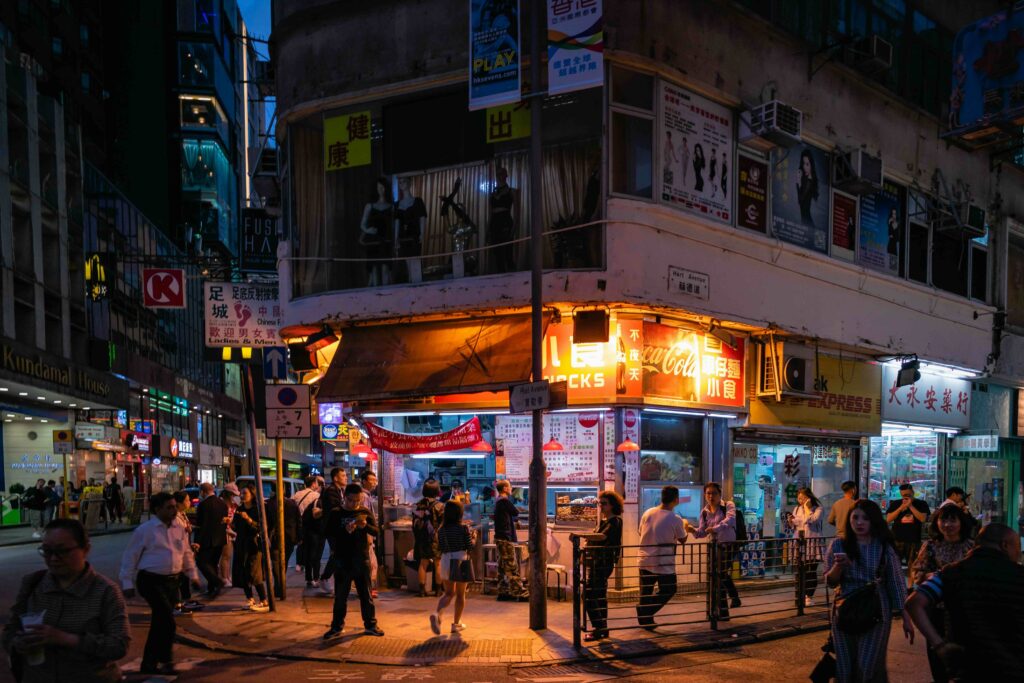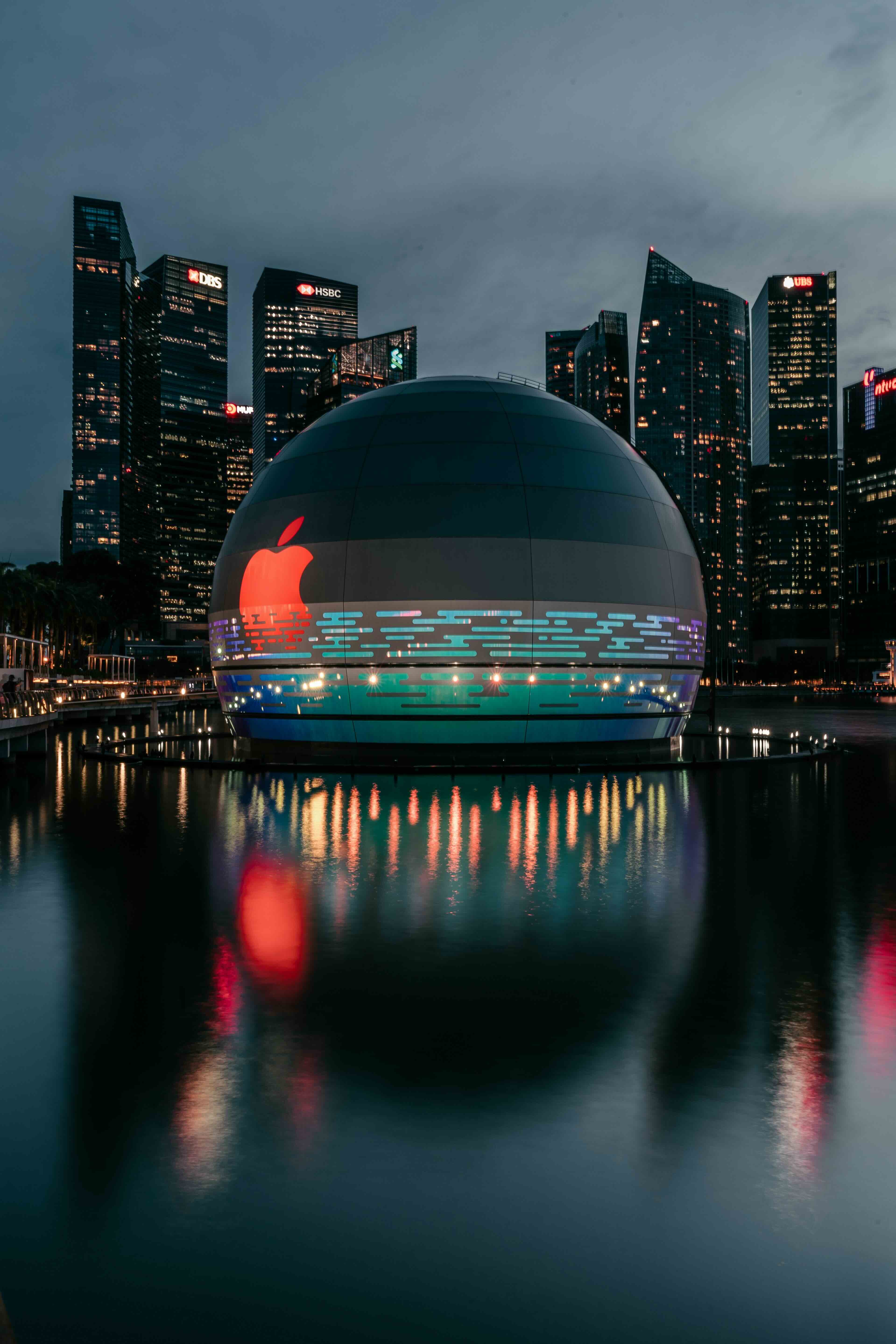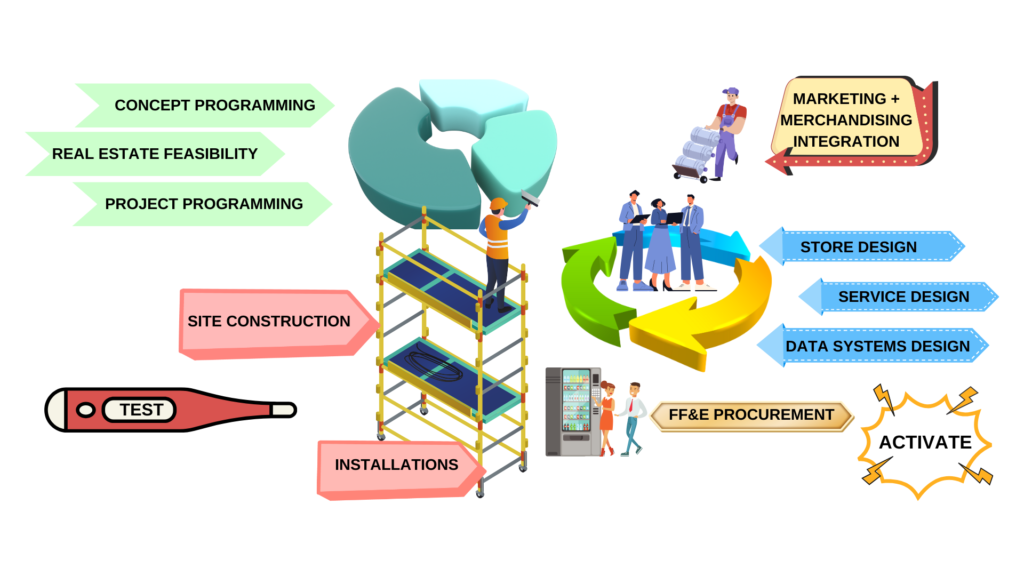
Better Retail Stores Make Better Retailers
[MISSION]

Better Retail Stores Make Better Retailers
[MISSION]
Stores are capex intensive.
Most times, it’s the most significant investment to make. A lot of them fail.
Over the years, retailers have invested significant resources in making their stores less relevant to consumers. As a mature retail market evolved, adapting to changing consumer preferences driven by new value propositions and digital experiences became essential.
Retailers sought to embrace online shopping behaviours and e-commerce while maintaining their revenue streams. They undertook significant transformations and digitized their vast marketing, sales, and supply chain systems. Then, the global pandemic shut their stores down and reminded consumers that it was better to shop elsewhere.
Yet here we are. The resilience of meaningful store experiences continues to inspire.
“A significant portion of consumer spending, about 82%, occurs in physical retail environments, indicating that despite the convenience of online shopping, many consumers still value in-person experiences”
Inc. Magazine
Competition is intensifying. The best retailers are developing their store channels as opportunities to connect deeper with their customers. There’s a return to community hubs and in-store shopping as robust acquisition and retention levers. Membership events or one-on-one brand interactions become higher-fidelity customer engagements over subscription boxes or asynchronous online chats.
From a deeper connection to actionable insights to improvements, the store is a flywheel of customer and brand value creation. It can become the space, sometimes the ultimate space, where a retailer can deliver the optimal experience. And so we continue to build them.
For me, this resonates back to architecture altruism, where retail’s path follows the human experience and appreciation of the endeavour. It’s those retailers focused on customer-centric work who create value by making better stores. And so do I.








Stores are capex intensive.
Most times, it’s the most significant investment to make. A lot of them fail.
Over the years, retailers have invested significant resources in making their stores less relevant to consumers. As a mature retail market evolved, adapting to changing consumer preferences driven by new value propositions and digital experiences became essential.
Retailers sought to embrace online shopping behaviours and e-commerce while maintaining their revenue streams. They undertook significant transformations and digitized their vast marketing, sales, and supply chain systems. Then, the global pandemic shut their stores down and reminded consumers that it was better to shop elsewhere.
Yet here we are. The resilience of meaningful store experiences continues to inspire.
“A significant portion of consumer spending, about 82%, occurs in physical retail environments, indicating that despite the convenience of online shopping, many consumers still value in-person experiences”
Inc. Magazine
Competition is intensifying. The best retailers are developing their store channels as opportunities to connect deeper with their customers. There’s a return to community hubs and in-store shopping as robust acquisition and retention levers. Membership events or one-on-one brand interactions become higher-fidelity customer engagements over subscription boxes or asynchronous online chats.
From a deeper connection to actionable insights to improvements, the store is a flywheel of customer and brand value creation. It can become the space, sometimes the ultimate space, where a retailer can deliver the optimal experience. And so we continue to build them.
For me, this resonates back to architecture altruism, where retail’s path follows the human experience and appreciation of the endeavour. It’s those retailers focused on customer-centric work who create value by making better stores. And so do I.


The Mission.
Empower retail brands to iterate more meaningfully in developing their store experiences, as a lever for driving profitable and sustainable business growth.
I can accomplish this first by highlighting strategic choices that may take time to be apparent. Some retailers can benefit from new options they didn’t know they had—a slight change with impactful downstream effects.
For others, a more integrated engagement makes sense. Perhaps a project or proof case activation is on the horizon. The development of their stores becomes more impactful when these strategic decisions are tailored to align with the brand’s growth strategy and aim at a specific result.
“Strategic store development is essential for retailers aiming to thrive in today’s competitive market. Integrating customer data and personalized experiences in physical stores can significantly enhance customer loyalty and drive sales”
Business of Fashion
To start, consider three foundational frameworks that will drive strategy and project outcomes: Project Management Methodology, Organizational Model, and Service Design. Exploring the choices within these frameworks can help identify potential opportunities in the development project.
I can accomplish this first by highlighting strategic choices that may take time to be apparent. Some retailers can benefit from new options they didn’t know they had—a slight change with impactful downstream effects.
For others, a more integrated engagement makes sense. Perhaps a project or proof case activation is on the horizon. The development of their stores becomes more impactful when these strategic decisions are tailored to align with the brand’s growth strategy and aim at a specific result.
“Strategic store development is essential for retailers aiming to thrive in today’s competitive market. Integrating customer data and personalized experiences in physical stores can significantly enhance customer loyalty and drive sales”
Business of Fashion
To start, consider three foundational frameworks that will drive strategy and project outcomes: Project Management Methodology, Organizational Model, and Service Design. Exploring the choices within these frameworks can help identify potential opportunities in the development project.

Project Management Methodology
If the first store iteration succeeded, a retailer might wait before choosing an alternate development method. They might not even iterate at all.
However, adapting to a different management methodology can have significant benefits. For example, compressing schedules is inherently easier with agile or critical chain methodologies, potentially leading to faster time to market and improved results compared to conventional systems.
Retail organizations often use critical path or waterfall management methodologies because they adapt to multiple stakeholders and varying degrees of complexity within retail organizations. However, these methodologies can be rigid to change, leading to longer schedules and higher resource usage.
A competitive advantage can be gained through hybrid systems that integrate the strengths of different methodologies. For example, using Agile for embedding strategic collaborations and Critical Chain for fast-tracking longer phases can enable achieving more in less time.
Imagine the potential unlocked in the customer experience when omnichannel data system integrations are aligned with in-store service design. Or consider how activating a project weeks ahead of projections could impact potential results.

Organizational Model
Store development involves many disparate activities, from initiation to activation.
Conventional systems can be rigid for passive retailers; however, there is more flexibility than most realize or leverage. Both internal and external structures can be optimized for risk and incentivized to achieve project goals.
Over the years, consolidation efficiencies have emerged within the legacy B2B vendor market serving retail development. These “all-in-one” vendors have consolidated two or more development functions into a differentiated service, such as professional architecture and engineering design firms, FF&E suppliers who will design and manufacture, or landlord developers who lease and build. If right-sized to project strategy and risk, they can be great enablement partners delivering operational efficiencies.
However, suppose the ideal combination cannot be found within the vendor base, the vendor is not incentivized to the development strategy, or there are too many tradeoffs. In that case, a project fit can also be arranged ad hoc. Identify the desired outcome, match functions to a strategic collaboration, and qualify and select preferred vendor players to establish a consolidated partnership.
Each store project is an opportunity to tailor-build a project-specific vendor base that is organized with a purpose.
In internal retail organizations, the principles for store development may differ slightly. These functions are often merged with Real Estate, Operations, or Marketing. The integrated benefits can sometimes fade over time as the focus shifts towards promoting outputs rather than outcomes. When store development, a capital expenditure activity, gets integrated into an operational expenditure activity, the tendency is to prioritize the latter.
But why settle for the status quo when there are ways to flatten the development structure and enhance agility and speed? Retail founders and CEOs who have managed important projects understand this concept well. A senior executive who sponsors, funds, and manages a project has the most agency on store development systems. Retailers have the chance to empower any role or function to improve project outcomes by following a similar model.
To minimize risk, the adjustments may be temporary or confined to the project duration. This approach may also have some fiscal accounting benefits through project capex amortization. Similarly, engaging freelance resources can improve cost-effectiveness and efficiency. B2B store development vendors make good use of the freelance market, and B2C could benefit from embracing the fragmented nature of store development systems more generally.

Service Design
Prior to the late 2010s, there was a prevalent approach to store development reminiscent of the “Field of Dreams” mindset — the belief that if you build it, they will come. Merchandising plans were about “stacking them high and watching them fly.” What prevailed were stores with an elevated warehouse experience and customer service more focused on facilitating transactional sales. This dynamic would shift as marketing-centric strategies created less and less value.
For retailers today, service design is vital in shaping customer experiences by aligning services with customers’ expectations and addressing service-related issues through practical design principles. Omnichannel initiatives are primary solutions to service design challenges, emphasizing the overall customer journey. The physical store environment remains a significant component of this journey, contributing at least 80% of all purchases.
With the focus on digital transformation, retailers are working to improve transactional sales efficiencies. Omnichannel solutions are clearly gaining traction as the market continues to evolve. Meanwhile, the reinvigoration of physical stores as hubs for 1-on-1 customer interactions, brand engagements, community activities, and hybrid online/offline experiences is also proving valuable.
“Innovative service design can lead to transformative customer experiences. Companies that invest in understanding and improving their service delivery often see a direct impact on their bottom line”
FAST COMPANY
The best retailers understand that being intentional about how a service is delivered is a massive differentiator. It may be counter-intuitive, but fostering in-person, hard-to-scale, real-time engagements undeniably creates the opportunity to build deeper relationships with their best customers. In this manner, Service Design has the potential to create value for retailers of any size and can be integrated into various aspects of business operations beyond customer-facing touchpoints.
Somehow, we can recognize a genuinely impactful customer service moment when we experience it. It could be the friendly staff at Costco offering free food samples or the sight of a Disney character refusing to let go of a hug until the child does. The experiential purpose is evident in these instances and always carries an emotional value.
At this convergence of empathy and experience, the store channel emerges as a unique platform. And by integrating Service Design into Store Development creates a more comprehensive and impactful outcome, encapsulating the core of Retail Experience Architecture.
Incorporating these frameworks into conventional store development systems can enhance business and customer metrics while addressing inherent challenges to the system (for more information about the issue, see here). By streamlining processes, integrating service design, and strategically incentivizing vendor partners, we can expedite project timelines significantly and increase production value. For many retailers, the ability to deliver speed and project capacity towards a specific objective represents a potent competitive advantage.
Ultimately, it’s essential to recognize that beyond these frameworks, crucial decisions require attention—decisions that should align with a retailer’s strategic direction and aspirations.
Let’s connect and explore what is possible.

Project Management Methodology
If the first store iteration succeeded, a retailer might wait before choosing an alternate development method. They might not even iterate at all.
However, adapting to a different management methodology can have significant benefits. For example, compressing schedules is inherently easier with agile or critical chain methodologies, potentially leading to faster time to market and improved results compared to conventional systems.
Retail organizations often use critical path or waterfall management methodologies because they adapt to multiple stakeholders and varying degrees of complexity within retail organizations. However, these methodologies can be rigid to change, leading to longer schedules and higher resource usage.
A competitive advantage can be gained through hybrid systems that integrate the strengths of different methodologies. For example, using Agile for embedding strategic collaborations and Critical Chain for fast-tracking longer phases can enable achieving more in less time.
Imagine the potential unlocked in the customer experience when omnichannel data system integrations are aligned with in-store service design. Or consider how activating a project weeks ahead of projections could impact potential results.

Organizational Model
Store development involves many disparate activities, from initiation to activation.
Conventional systems can be rigid for passive retailers; however, there is more flexibility than most realize or leverage. Both internal and external structures can be optimized for risk and incentivized to achieve project goals.
Over the years, consolidation efficiencies have emerged within the legacy B2B vendor market serving retail development. These “all-in-one” vendors have consolidated two or more development functions into a differentiated service, such as professional architecture and engineering design firms, FF&E suppliers who will design and manufacture, or landlord developers who lease and build. If right-sized to project strategy and risk, they can be great enablement partners delivering operational efficiencies.
However, suppose the ideal combination cannot be found within the vendor base, the vendor is not incentivized to the development strategy, or there are too many tradeoffs. In that case, a project fit can also be arranged ad hoc. Identify the desired outcome, match functions to a strategic collaboration, and qualify and select preferred vendor players to establish a consolidated partnership.
Each store project is an opportunity to tailor-build a project-specific vendor base that is organized with a purpose.
In internal retail organizations, the principles for store development may differ slightly. These functions are often merged with Real Estate, Operations, or Marketing. The integrated benefits can sometimes fade over time as the focus shifts towards promoting outputs rather than outcomes. When store development, a capital expenditure activity, gets integrated into an operational expenditure activity, the tendency is to prioritize the latter.
But why settle for the status quo when there are ways to flatten the development structure and enhance agility and speed? Retail founders and CEOs who have managed important projects understand this concept well. A senior executive who sponsors, funds, and manages a project has the most agency on store development systems. Retailers have the chance to empower any role or function to improve project outcomes by following a similar model.
To minimize risk, the adjustments may be temporary or confined to the project duration. This approach may also have some fiscal accounting benefits through project capex amortization. Similarly, engaging freelance resources can improve cost-effectiveness and efficiency. B2B store development vendors make good use of the freelance market, and B2C could benefit from embracing the fragmented nature of store development systems more generally.

Service Design
Prior to the late 2010s, there was a prevalent approach to store development reminiscent of the “Field of Dreams” mindset — the belief that if you build it, they will come. Merchandising plans were about “stacking them high and watching them fly.” What prevailed were stores with an elevated warehouse experience and customer service more focused on facilitating transactional sales. This dynamic would shift as marketing-centric strategies created less and less value.
For retailers today, service design is vital in shaping customer experiences by aligning services with customers’ expectations and addressing service-related issues through practical design principles. Omnichannel initiatives are primary solutions to service design challenges, emphasizing the overall customer journey. The physical store environment remains a significant component of this journey, contributing at least 80% of all purchases.
With the focus on digital transformation, retailers are working to improve transactional sales efficiencies. Omnichannel solutions are clearly gaining traction as the market continues to evolve. Meanwhile, the reinvigoration of physical stores as hubs for 1-on-1 customer interactions, brand engagements, community activities, and hybrid online/offline experiences is also proving valuable.
“Innovative service design can lead to transformative customer experiences. Companies that invest in understanding and improving their service delivery often see a direct impact on their bottom line”
FAST COMPANY
The best retailers understand that being intentional about how a service is delivered is a massive differentiator. It may be counter-intuitive, but fostering in-person, hard-to-scale, real-time engagements undeniably creates the opportunity to build deeper relationships with their best customers. In this manner, Service Design has the potential to create value for retailers of any size and can be integrated into various aspects of business operations beyond customer-facing touchpoints.
Somehow, we can recognize a genuinely impactful customer service moment when we experience it. It could be the friendly staff at Costco offering free food samples or the sight of a Disney character refusing to let go of a hug until the child does. The experiential purpose is evident in these instances and always carries an emotional value.
At this convergence of empathy and experience, the store channel emerges as a unique platform. And by integrating Service Design into Store Development creates a more comprehensive and impactful outcome, encapsulating the core of Retail Experience Architecture.
Incorporating these frameworks into conventional store development systems can enhance business and customer metrics while addressing inherent challenges to the system (for more information about the issue, see here). By streamlining processes, integrating service design, and strategically incentivizing vendor partners, we can expedite project timelines significantly and increase production value. For many retailers, the ability to deliver speed and project capacity towards a specific objective represents a potent competitive advantage.
Ultimately, it’s essential to recognize that beyond these frameworks, crucial decisions require attention—decisions that should align with a retailer’s strategic direction and aspirations.
Let’s connect and explore what is possible.